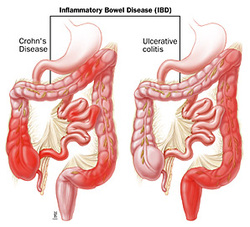|
|
Pathology definition - Crohn's disease

Crohn’s disease
Patient who suffer from Crohn’s disease may present with symptoms and signs such as diarrhea, mass on the right lower quadrant, erythema nodosum, ankylosing spondylitis, low grade fever, right lower quadrant pain, oral aphthous ulcers, perianal fistula, uveitis, migratory poly arthritis, sacroiliitis, malabsorption syndrome and intestinal perforation as well as intestinal obstruction from fibrous stricture.
Crohn’ disease mostly affect young women with the age average of 15 - 30 years. The causes of Crohn’s disease are unknown. Mostly the cause of Crohn’s disease is idiopathic. Crohn’s disease is part of inflammatory bowel disease besides ulcerative colitis.
Pathologically, Crohn’s disease may present with non caseating granulomas, thickened wall of the bowel , submucosal edema/cobblestone mucosa with elevation of remaining mucosa, creeping of fat over the surface of the bowel, metaplasia of the mucosal, transmural inflammation, linear ulceration of the mucosa,crypts atrophy and skip lesions( area of diseased bowel interspersed with normal bowel). Crohn’s disease mostly affecting the terminal ileum, colon and small intestine. Rectum is excluded in Crohn’s disease.
Colonoscopy studies may reveal fistula, stricturing and ulceration of the colon and small intestine. Barium swallow and x ray studies may reveal the narrowing of the lumen of the bowel ( string signs).
The treatment of Crohn’s disease include steroid therapy ( glucocorticoids), anti - inflammatory agents, ( sulfasalazine ) and anti diarrheal and antibiotics.
References
1.M, Tanaka, and Riddell Rh. “The Pathological Diagnosis and Differential Diagnosis of Crohn’s Disease.” Hepato-Gastroenterology 37, no. 1 (February 1990): 18–31.
2.Lennard-Jones, J. E. “Classification of Inflammatory Bowel Disease.” Research-article, July 8, 2009.
Patient who suffer from Crohn’s disease may present with symptoms and signs such as diarrhea, mass on the right lower quadrant, erythema nodosum, ankylosing spondylitis, low grade fever, right lower quadrant pain, oral aphthous ulcers, perianal fistula, uveitis, migratory poly arthritis, sacroiliitis, malabsorption syndrome and intestinal perforation as well as intestinal obstruction from fibrous stricture.
Crohn’ disease mostly affect young women with the age average of 15 - 30 years. The causes of Crohn’s disease are unknown. Mostly the cause of Crohn’s disease is idiopathic. Crohn’s disease is part of inflammatory bowel disease besides ulcerative colitis.
Pathologically, Crohn’s disease may present with non caseating granulomas, thickened wall of the bowel , submucosal edema/cobblestone mucosa with elevation of remaining mucosa, creeping of fat over the surface of the bowel, metaplasia of the mucosal, transmural inflammation, linear ulceration of the mucosa,crypts atrophy and skip lesions( area of diseased bowel interspersed with normal bowel). Crohn’s disease mostly affecting the terminal ileum, colon and small intestine. Rectum is excluded in Crohn’s disease.
Colonoscopy studies may reveal fistula, stricturing and ulceration of the colon and small intestine. Barium swallow and x ray studies may reveal the narrowing of the lumen of the bowel ( string signs).
The treatment of Crohn’s disease include steroid therapy ( glucocorticoids), anti - inflammatory agents, ( sulfasalazine ) and anti diarrheal and antibiotics.
References
1.M, Tanaka, and Riddell Rh. “The Pathological Diagnosis and Differential Diagnosis of Crohn’s Disease.” Hepato-Gastroenterology 37, no. 1 (February 1990): 18–31.
2.Lennard-Jones, J. E. “Classification of Inflammatory Bowel Disease.” Research-article, July 8, 2009.
